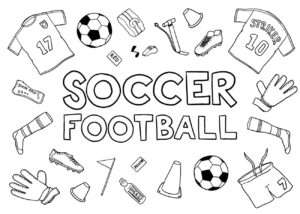There are 11 positions on the soccer field, but they always fall into four broad categories. Even in smaller games, the number of players in each category may change, but by and large, the positions do not.
The Goalkeeper
The goalkeeper is the only player allowed to use his hands and that can only occur within the confines of the penalty area. There are never more that two goalkeepers on the field at any time — one on each team.
The goalkeeper’s uniform is different from the rest of his team’s to make it obvious which player may use his hands. The jersey, often with long sleeves, is colored to clash with the others. And since the 1970s, goalkeepers have worn gloves to both protect their hands and enhance their grip on the ball.
The Defenders
A defender’s primary duty is to win back the ball from the opposition and prevent them from scoring. Teams play with anywhere from three to five at the back and each member of the defense tends to have a different, yet equally important duty.
The defenders stationed in the center of the back line (known as central defenders or center backs) tend to be some of the taller and stronger members of the team since they so frequently have to win the ball in the air. They go forward very little, except on set pieces, and hold a position of great responsibility.
The defenders on the flanks (known as wingbacks in five-player defenses, or fullbacks) are usually smaller, quicker, and better on the ball. Their job is to shut down attacks coming down the sides, but they are also frequently a key component of their side’s offense.
Pushing up the sidelines, they are able to support the midfielders and push deep into opposition territory to deliver crosses.
The Midfielders
The midfield is one of the most demanding places to play on the soccer pitch. Midfielders are usually the fittest members of a team, since they do the most running. They share the responsibilities of the defenders and the forwards since they must both win the ball back and create opportunities up front.
The various midfielders’ roles depend heavily on a team’s particular system. Those on the flank may be asked to primarily deliver crosses or cut into the middle with different degrees of defensive accountability. Those in the center, meanwhile, may be asked to mainly hold the ball and win it back (such as a “holding midfielder” or an “anchor”) or venture forward and feed balls to the attackers. The best midfielders are versatile enough to offer a team both.
In a full game, teams play with anywhere from three to five midfielders, arranging them in different shapes. Some will have the five line up straight across the field, while others will have the middle two or three set up one behind the other in what is known as a “diamond” formation.
The Forwards
The forwards may have the most straightforward job description on the field: score goals. Forwards (also known as attackers or strikers) come in all shapes and sizes and, accordingly, present different threats. A taller striker could be more dangerous in the air, while a smaller, quicker player may be more effective with the ball at his feet.
Teams play with anywhere from one to three strikers (sometimes four if times get desperate) and try to blend different styles. The objective is for the forwards to have a good understanding of each other’s game to better set up opportunities for each other.
Frequently, one forward will play a little deeper than the other to collect the ball sooner and open up a defense. Those players, who tend to be the most creative on the team, are traditionally called a “Number 10,” in reference to the jersey number they usually wear.
Hybrid Positions
There are two positions that sometimes crop up in soccer which are never played by more than one person at a time. They are sweeper and “libero,” which is sometimes called a “midfield sweeper.”
A regular sweeper plays just behind the central defenders and acts as a last line with a lot of freedom to cover where danger presents itself. A midfield sweeper usually plays just in front of the defense and helps to slow down opposing attacks by acting as one extra barrier.





